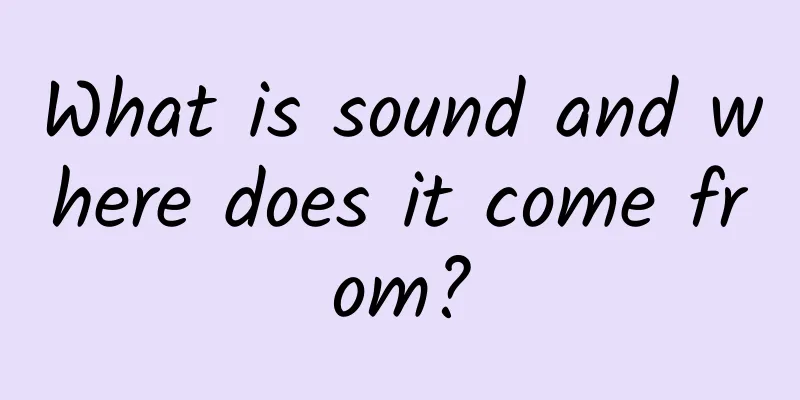What is sound and where does it come from?

|
“Ding-ling-ling——” From the first crisp sound of the alarm clock in the morning, footsteps, running water, voices - all kinds of sounds pour into our ears one after another. Except when we are sleeping, we can hear them almost all the time. But what are the sounds? And where do they come from? Although sound cannot be touched or seen, there is a way to indirectly "touch" and see it. Take out your toy drum, put your left hand on one side of the drumhead, and use your right hand to hit the other side with a drumstick. At the same time, observe the drumhead carefully. Do you feel it? Yes, the drum surface is vibrating, which is the essence of sound - sound waves generated by the vibration of an object. The drum that makes the "dong dong dong" sound is the "sound source", that is, the source of the sound. But how do the sound waves generated by the vibrating drum reach our ears? Although there is no telephone line connecting the drum to us, there are actually sound messengers everywhere around us - air. There are many nitrogen, oxygen and other gas molecules in the air. The vibration of the drum drives the vibration of the gas molecules nearby, and then, like a relay race, the sound waves are transmitted to all directions and to our ears. We also have a "snake drum" in our ears - the eardrum, which is a translucent membrane. When sound waves pass through the external auditory canal, they hit it and cause it to vibrate. The eardrum then transmits the vibration to the auditory ossicles and finally to the fluid in the cochlea, causing the fluid to fluctuate. This fluctuation is converted into nerve impulses by nerve cells and transmitted to the auditory nerve center in the brain, allowing us to hear the sound. In the macroscopic world, air, water, or solids can all serve as media for sound propagation. Without a medium, sound cannot propagate. The first person to discover this was the 17th-century British physicist Robert Boyle. At that time, he conducted a very famous experiment. Boyle put an alarm clock into a large glass cover and let the alarm clock keep ringing. Even with the glass cover blocking it, everyone could still clearly hear the alarm clock's constant noisy sound. Then, Boyle performed a "magic trick" and made the alarm clock quiet down! He used a vacuum pump to remove the air in the glass cover. As the air became less and less, the sound of the alarm clock became weaker and weaker, and finally it was almost inaudible. But as soon as the glass cover was opened, the alarm clock started to ring again. Now we know that this is because the propagation of sound requires a medium. In our daily lives, the most important medium for sound propagation is air. People use this principle to create soundproof windows. It is made of two sides of glass with an almost vacuum in the middle, which is like setting a gap for sound waves, preventing them from crossing to the other side of the window. Although the propagation of sound requires a medium in the macroscopic world, the microscopic quantum world breaks this rule. Not long ago, scientists discovered that a vacuum can also propagate sound over a very short distance! In fact, the vacuum is not empty. It does not have physical particles such as atoms and molecules, but there are quantum fields composed of "virtual particles", similar to the electric field formed by electrons. They are constantly generated and disappear, just like the small water droplets stirred up by the oscillation of water waves, bouncing up and falling back. This phenomenon is called quantum fluctuation. Scientists have found that when two films in a vacuum are very close, the vibration of one film can be transmitted to the other film through quantum fluctuations, which means that sound waves pass through the vacuum! However, this phenomenon is currently limited to the wonderful quantum world. In our macroscopic world, a medium is still needed to hear sound. References: Fong, KY, Li, H., Zhao, R. et al. (2019). Phonon heat transfer across a vacuum through quantum fluctuations. Nature 576, 243–247 Author:Mirror Reviewer: Zhang Xuanzhong (popular science writer, member of the Chinese Physical Society) |
>>: Can large language models reason? | AI Nasi
Recommend
Is it good to use mugwort to fumigate hemorrhoids?
Moxibustion is a kind of therapy in Traditional C...
How to consume maca
There are many ways to consume maca, but no matte...
The "Beijing Man" who disappeared in the war tells us the value of peace
Beijing is a city with a history of more than 3,0...
The efficacy and function of chicken feet
Chicken feet in our lives Chicken feet have attra...
What is the function of pine pollen
Why do many people now like to eat pine pollen fo...
The efficacy and function of wind-proof flower
Everyone is familiar with the wind-blown flower. ...
The efficacy and function of orange peel
Orange is a fruit that many people love to eat. T...
AI fortune-telling becomes a new favorite, "cyber palm reading" is really not metaphysics! 丨 Interesting Science of the Week
01 Supersolid matter achieves ultra-low temperatu...
Side Effects of Bamboo Ru
Bamboo mushroom is a Chinese herbal medicine. It ...
The efficacy and function of tung leaves
As people's living standards continue to impr...
Not everyone can have laser myopia surgery?
Mixed Knowledge Specially designed to cure confus...
The Year of the Snake is coming. Let’s grow a plant with a “snake” in it! These plants can be selected →
The auspicious dragon shakes its tail to bid fare...
Why are dolphins the nemesis of sharks?
You may have heard that dolphins are sharks' ...
What exactly made snail noodles smell bad?
Mixed Knowledge Specially designed to cure confus...
The efficacy and function of forsythia leaves
There are so many medicinal herbs in the world, a...









